光度学基础学习笔记
- 格式:docx
- 大小:581.51 KB
- 文档页数:9



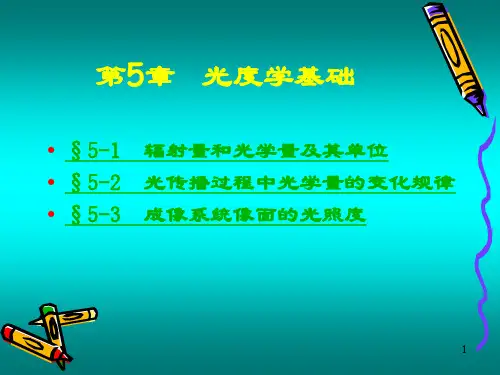

光度学基础光度学是研究光的流动和光能的传播的科学,也是物理学的一个分支。
它研究光的性质、光的产生、传播、相互作用以及光与物质之间的相互作用等方面的内容。
在光度学中,我们关注的是光的强度、光的波长、光的频率以及光的速度等基本特性。
光的强度是指光的能量在单位时间内通过单位面积的流量,也就是单位时间内光通过的功率。
在国际单位制中,光的强度的单位是瓦特/平方米(W/m²)。
光的强度是光度学中最基本的量度,它可以用来描述光源的亮度。
当光的强度增大时,我们感觉到的亮度也会增加。
光的波长是指光波在传播过程中一个完整波动所需的距离。
在光度学中,我们常用纳米米(nm)来表示光的波长。
不同波长的光会引起不同的视觉效果,例如红光的波长较长,而紫光的波长较短。
光的波长还与光的颜色有关,我们常见的七彩光谱就是由不同波长的光组成的。
光的频率是指单位时间内光波的震动次数。
光的频率与光的波长有关系,它们之间的关系可以用光速来计算。
光速是光在真空中传播的速度,它是一个常数,约为每秒30万公里。
光的频率和波长满足一个简单的关系,即频率乘以波长等于光速。
因此,当光的波长变长时,光的频率会相应变小。
光的速度是光度学中非常重要的一个特性。
光的速度是自然界中最快的速度,它在真空中的数值约为每秒30万公里。
光的速度在不同介质中会发生变化,通常情况下,光在介质中的传播速度会比在真空中的传播速度慢。
这是因为光在介质中会与介质中的原子或分子相互作用,导致传播速度减小。
除了以上几个基本特性外,光度学还研究光与物质之间的相互作用。
光与物质之间的相互作用可以分为吸收、反射、折射和散射等几种形式。
当光通过物质时,物质会吸收光的能量,这就是光的吸收现象。
当光遇到物体表面时,一部分光会被物体表面反射回来,这就是光的反射现象。
当光从一种介质传播到另一种介质时,光的传播方向会发生改变,这就是光的折射现象。
当光通过物质时,光与物质中的微粒相互作用,导致光的传播方向发生随机改变,这就是光的散射现象。
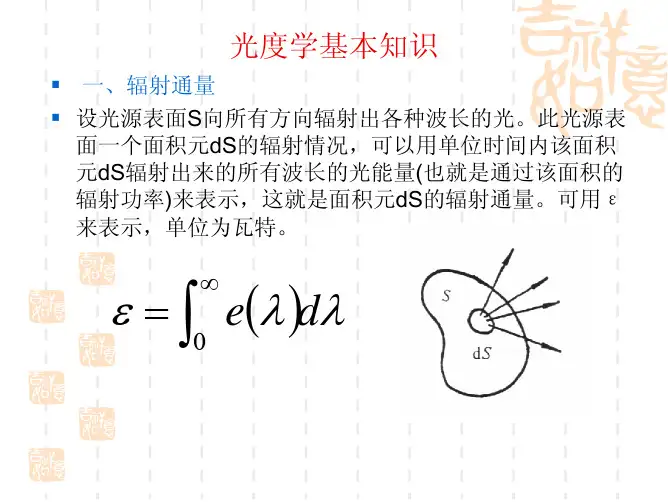

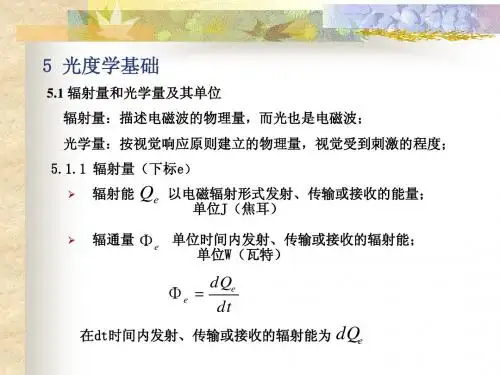
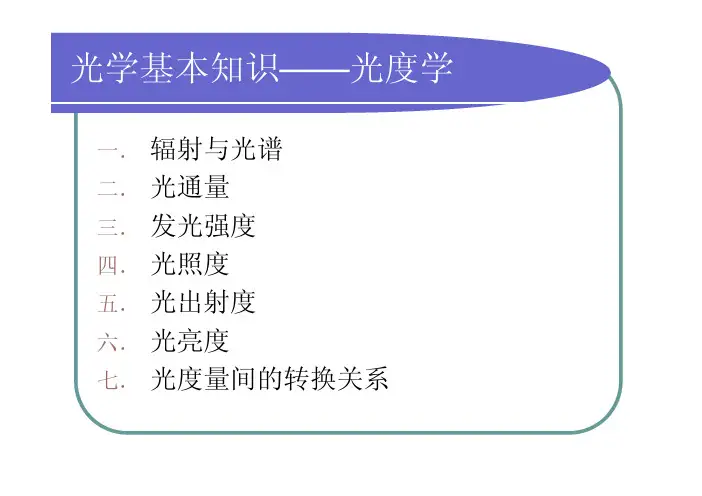
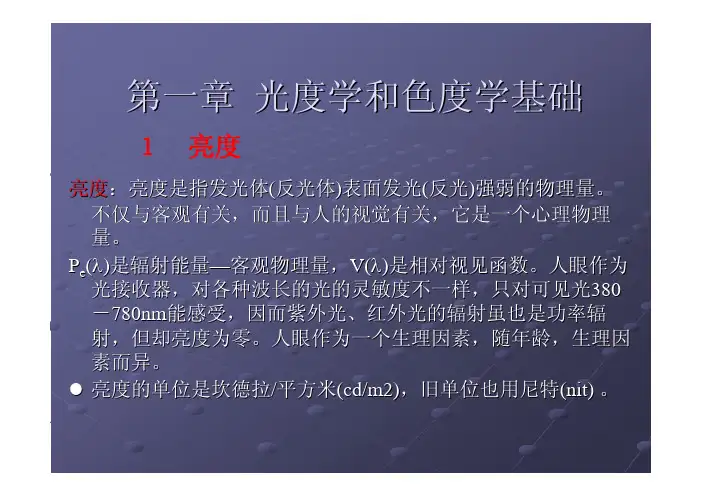
亮度第一章光度学和色度学基础1亮度可见度2可见度3 光通量光通量是按人眼的光感觉来度量的辐射功率,用符号3相对视见函数视见函数3相对视见函数暗适应双重视觉论锥体细胞明视觉杆体细胞暗视觉4各种亮度的实例5颜色的基本特性什么是颜色视觉系统能感觉的波长范围为纯颜色用光的波长定义,称为光谱色用不同波长的光进行组合时可产生相同的颜色感觉显示器件的多色性可大大增加显示的信息和功能。
颜色是可以定量表示的。
5颜色的基本特性5颜色的基本特性颜色消色和彩色光谱色和混合色5颜色的基本特性CIE(国际照明委员会)表色体系孟塞尔表色体系色调、明度、饱和度6CIE 1931标准色度系统定量表示颜色的体系称为色坐标,发光的颜色可由色坐标中的点来表示。
6CIE 1931标准色度系统7三基色标准的光谱分布-光谱三刺激值8CIE 1931 标准色度观察者光谱三刺激值x y z x y z单色光复合光9CIE 色度图10 色坐标计算=450nm的单色光,由表得x y zx x+y+zy x+y+zz x+y+z自然界中任何一种可能的颜色都在舌形及其下端连线之内,此范围外的点均为不存在的颜色。
xyz10 单色光色坐标计算x(λ)、y(λ) 、z(λ)x(λ)y(λ)z(λ)11色差椭圆图向各个方向的辐射线11恰可察觉色差椭圆图12主波长和色纯度颜色S 1的主波长颜色S 2的补色波长13等色调波长线和等饱和度线等色调波长线:等饱和度线14 电视的色域15 色域(Color Gamut)计算公式15 色域(Color Gamut)计算公式16 色域与显示效果40045050055060065070017LCD Backlightand Color Gamut CFs, CCFL, LED CIE 1976 Chromaticity CCFL LEDMost NB & LCD monitorsuse LED BLU R. Lu et al, Opt. Express 14, 6243 (2006)18 孟塞尔表色体系 用色调、饱和度和明色调用角度标定,红饱和度的深浅用半径明度用垂直轴表示采用色调H、明度V。

光度学基础学习笔
记——Photometry principles
简介
光度学是1760年由朗伯建立的,且定义了光通量、发光强度、照度、亮度等主要光学光度学参量,并用数学阐明了它们之间的关系和光度学几个重要定律,如照度的叠加性定律、距离平方比定律、照度的余弦定律等,这些定律一直沿用至今,实践已证明是正确的。
在可见光波段内,考虑到人眼的主观因素后的相应计量学科称为光度学。
▪
参量定义
光度学(Photometry )的核心定义是光通量Φ,单位是流明,可以理解为光能的功率。
其他定义与其的关系如下:
光通量Φ 单位
lm
发光强度I 单位lm/sr
I=d Φ/d ω= r 2*d Φ/(cos θ*d A)辅照度E 单位lm/m 2
E= d Φ/*d A
其中d ω=cos θ*d A/r 2辅射度L
单位lm/(sr*m 2)
L= d 2Φ/(cos θ*d A*d ω)
单位方向角内的光通量=单位圆上
单位透视缩小面积上的光通量
单位面积接受的光通量
单位透视缩小面积单位辐射角接受
/发出的光通量
BRDF=L/E
dI=r 2Ld ω
▪双向反射分布函数
BRDF被定义为物体表面处辐射度和辐照度的比值(单位sr-1):
f(x,ωi,ωo)=L0(x,ωo)
E i(x,ωi)
=
L0(x,ωo)
d∅
dA
=
L0(x,ωo)
I i(x,ωi)
dω
dA
=
L0(x,ωo)
I i(x,ωi)cosθi/r2
整理后得到点光源情况下辐射度的公式:
L0(x,ωo)=I i(x,ωi)cosθi f(x,ωi,ωo)
r2
因:dI i(x,ωi)=r2L i(x,ωi)dω带入上式,得到光源不是点光源情况下,如光源区域在Ω内,辐射度的公式:
L0(x,ωo)=∫L i(x,ωi)cosθi f(x,ωi,ωo)dω
Ω
▪典型反射模型
Lambert:f(x,ωi,ωo)=const
I0=kI i〈l,n〉——l:light norm,n:surface norm 描述:理想漫反射模型
Lommel-Seelinger:f(x,ωi,ωo)=const
一般p(α)=1
——μ0=cosϖi,μ=cosϖo,ϖ:single scattering albedo单次照射散射率描述:月球天体模型
Lunar-Lambert:
描述:月球天体模型
Phong:I0=k a I a+k d I i〈l,n〉+k s I i〈r,v〉s
——r:perfect ref norm,v:view norm,
——I a:envirument light,s:surface smoothness 描述:漫反射与镜面反射综合模型
Oren–Nayar
The surface roughness model used in the derivation of the Oren-Nayar model is the microfacet model, proposed by Torrance and Sparrow,[2] which assumes the surface to be composed of long symmetric V-cavities. Each cavity consists of two planar facets. The roughness of the surface is specified using a probability function for the distribution of facet slopes. In particular, the Gaussian distribution is often
used, and thus the variance of the Gaussian distribution, , is a measure of the roughness of the surfaces. The standard deviation of the facet slopes (gradient of the surface elevation), ranges in .
In the Oren–Nayar reflectance model, each facet is assumed to be Lambertian in reflectance. As shown in the image at right, given the radiance of the incoming light
, the radiance of the reflected light , according to the Oren-Nayar model, is
Where
and is the albedo of the surface, and is the roughness of the surface. In the case of (i.e., all facets in the same plane), we have , and , and thus the Oren-Nayar model simplifies to the Lambertian model:
Minnaert function
From Wikipedia, the free encyclopedia
The Minnaert function is a photometric function used to interpret astronomical observations [1][2] and remote sensing data for the Earth.[3] This function expresses the radiance factor (RADF) as a function the phase angle () and the photometric latitude () and the photometric longitude ().
where is the Minnaert albedo, is an empirical parameter, is the
scattered radiance in the direction , ,is the incident radiance, and
The phase angle is the angle between the light source and the observer with the object as the center.
The assumptions made are:
the surface is illuminated by a distant point source.
the surface is isotropic and flat.
Minnaert's contribution is the introduction of the parameter , having a value between 0 and 1,[4] originally for a better interpretation of observations of the Moon. In remote sensing the use of this function is referred to as Minnaert topographic correction, a necessity when interpreting images of rough terrain.
参考文献:
[1]. 维基百科:/wiki/光度学
[2]. 维基百科:/wiki/Oren–Nayar_reflectance_model
[3]. 维基百科:/wiki/Phong_reflection_model
[4]. 维基百科:
/wiki/Bidirectional_reflectance_distribution_function
[5]. 维基百科:/wiki/Minnaert_function
[6]. http://space.unibe.ch/staff/thomas/07_Photometry_Rev.pdf
[7]. http://www.astro.uvic.ca/~tatum/plphot/plphot03.pdf,Chapter 3. A Brief History of the Lommel-Seeliger Law.
[8].郑作勇, 基于图像的带高光物体的形状和反射属性建模技术研究, 2009, 上海交通大学.
[9].杨磊, 韩九强, 王国珲,基于Shape - from - Shading 的月球表面三维形状
恢复算法研究,宇航学报,2008.11,29(6),1995~2000
[10].Maxwell B.Fairbairn,Planetary Photometry:The Lommel-Seeliger Law,The Royal Astronomical Society of Canada,NASA Astrophysics Data System。